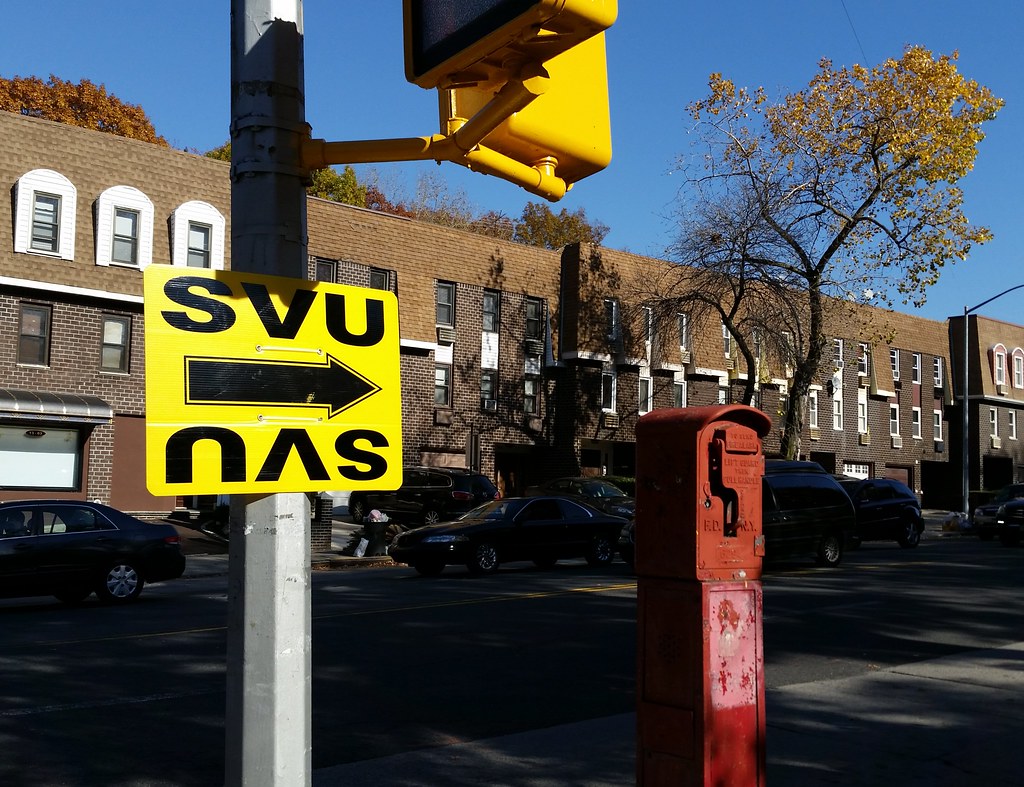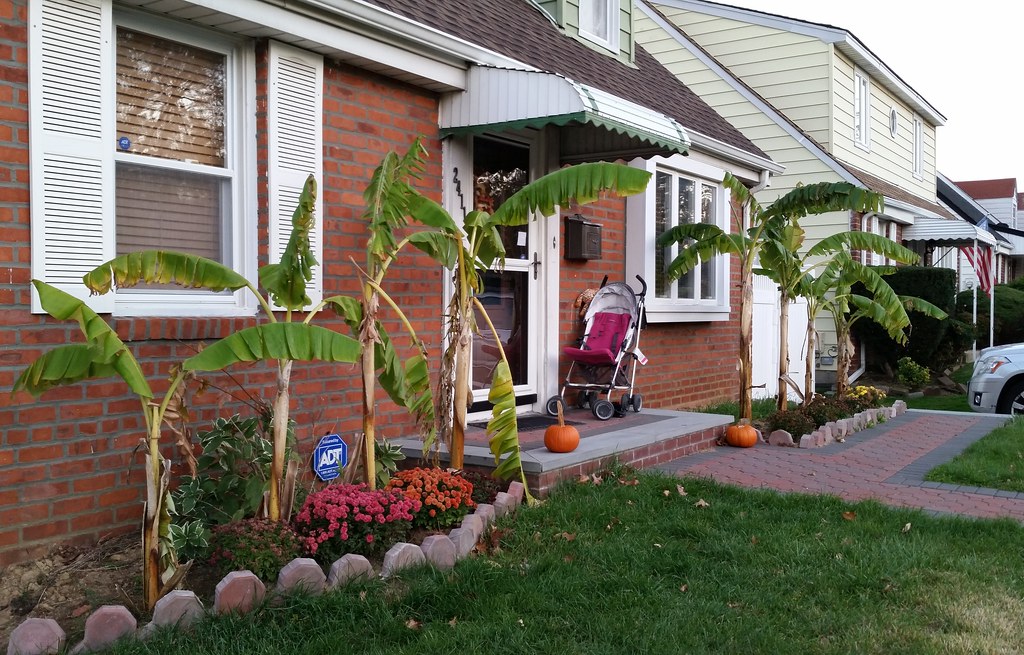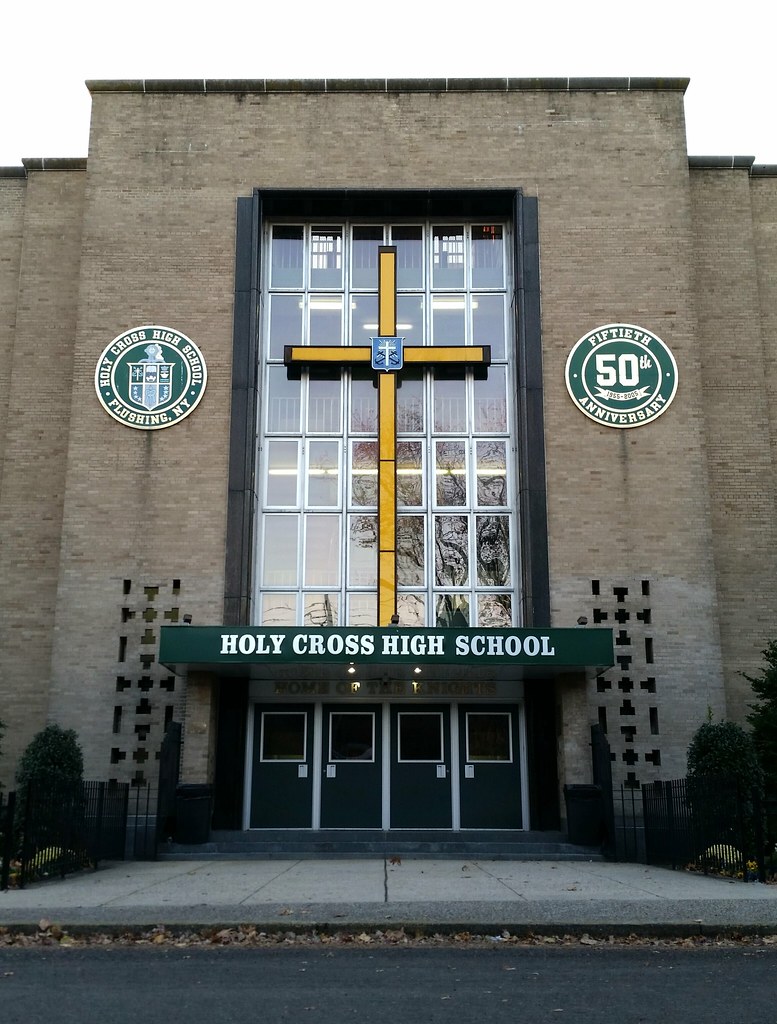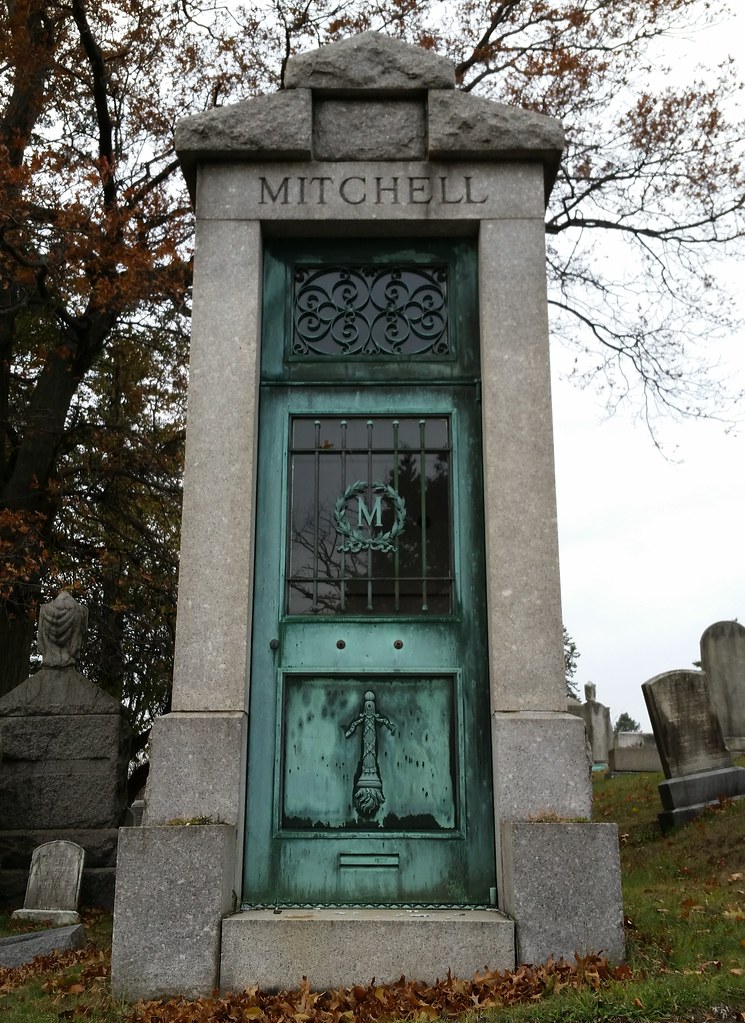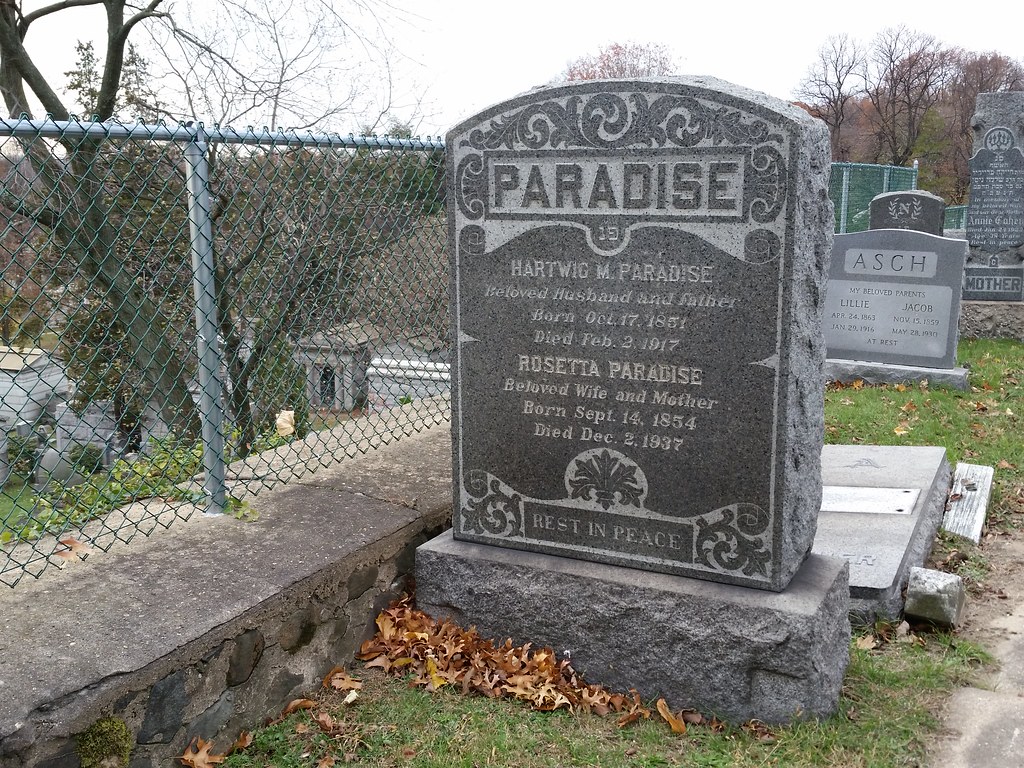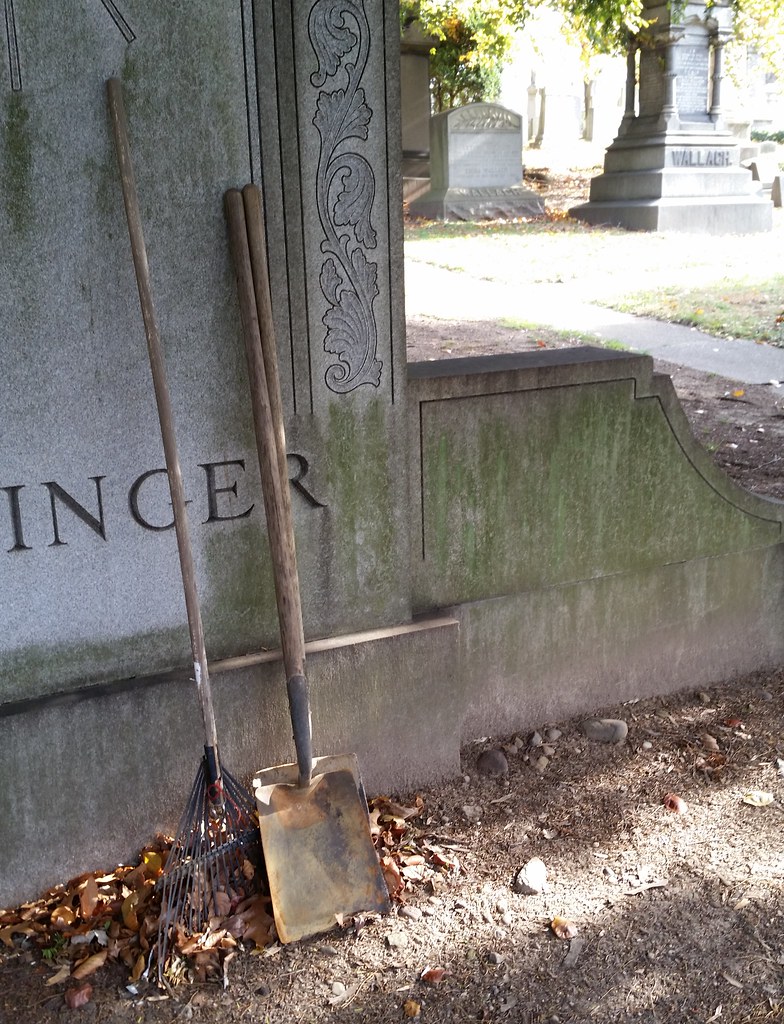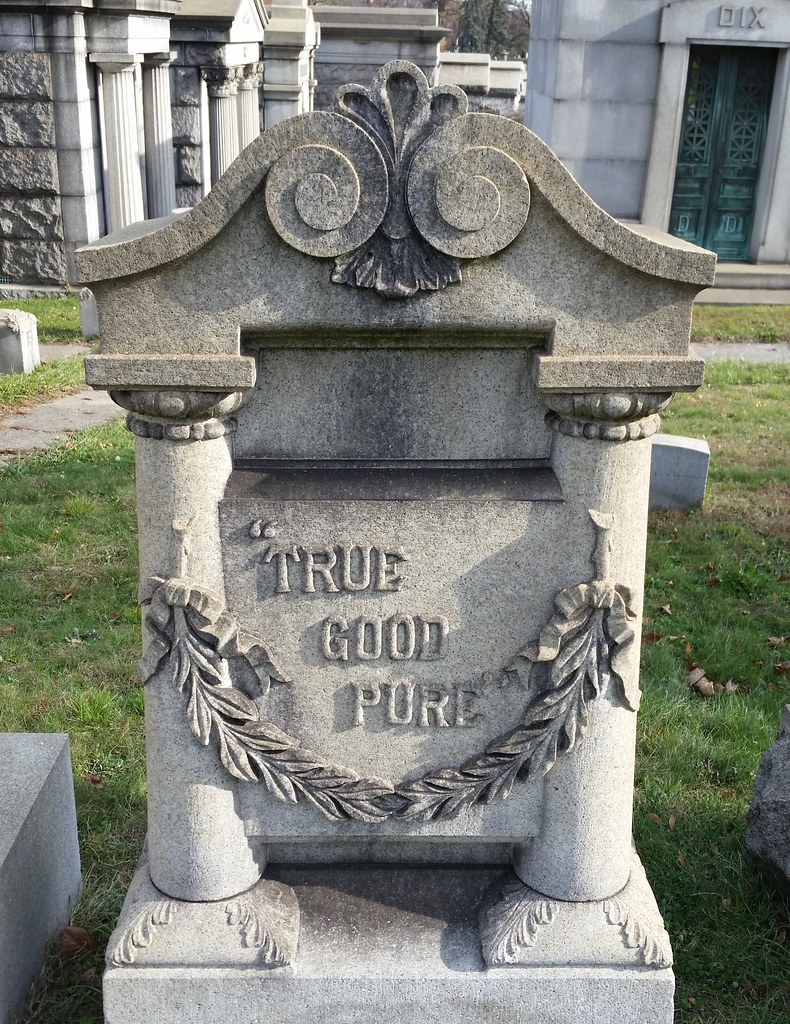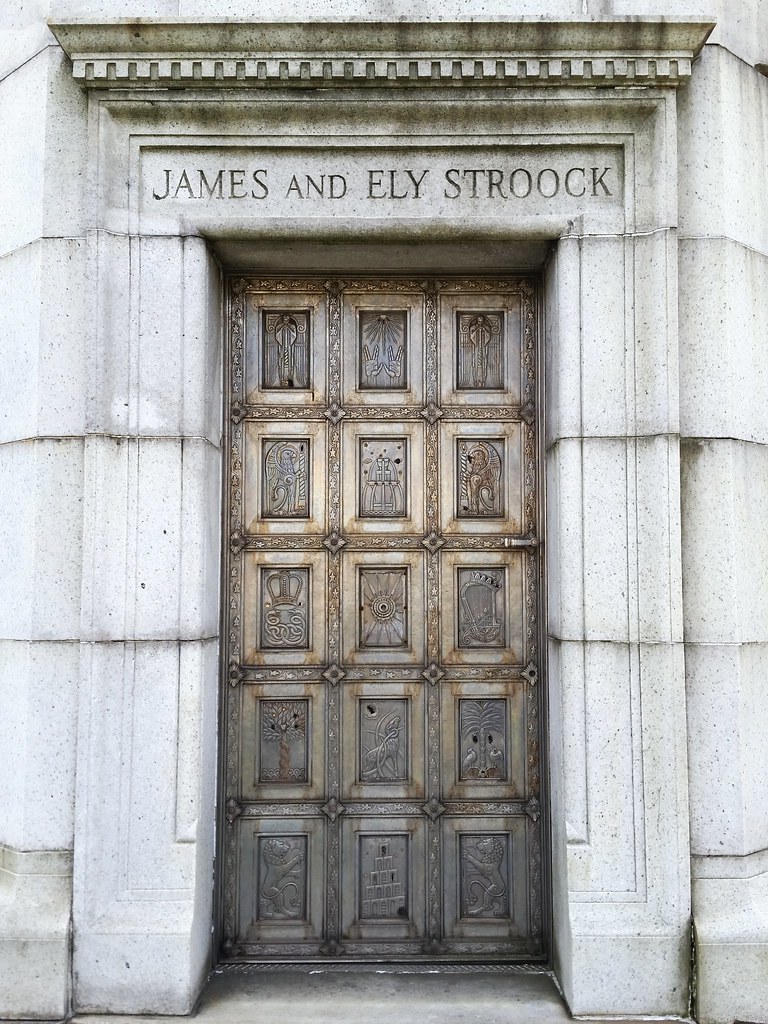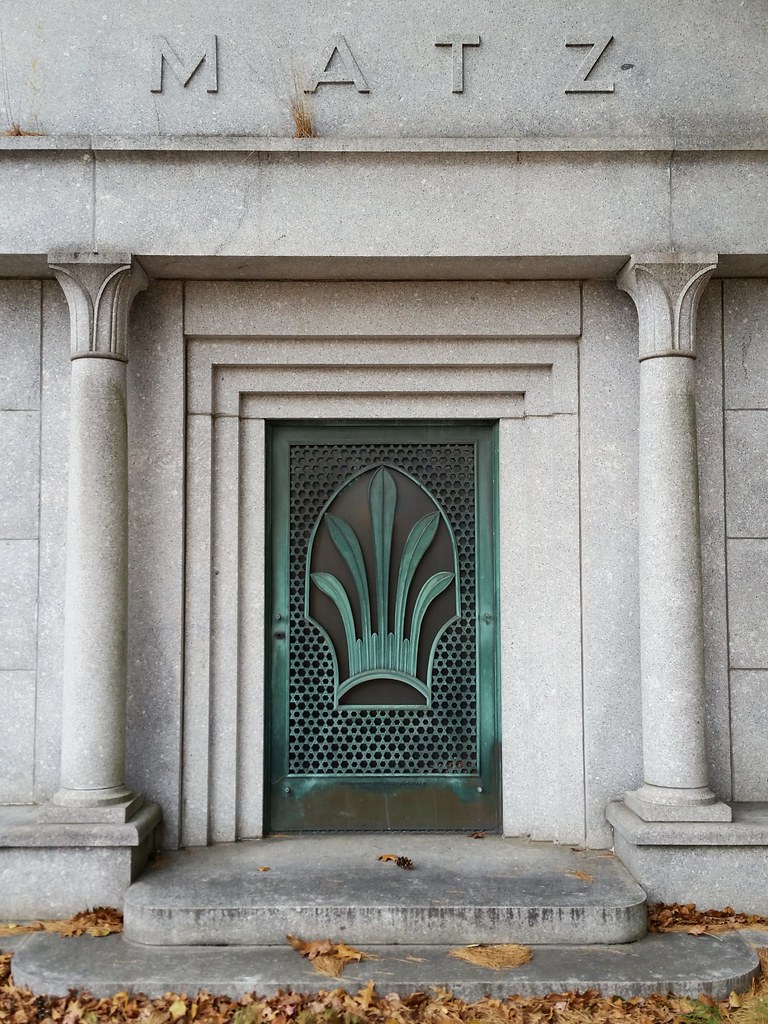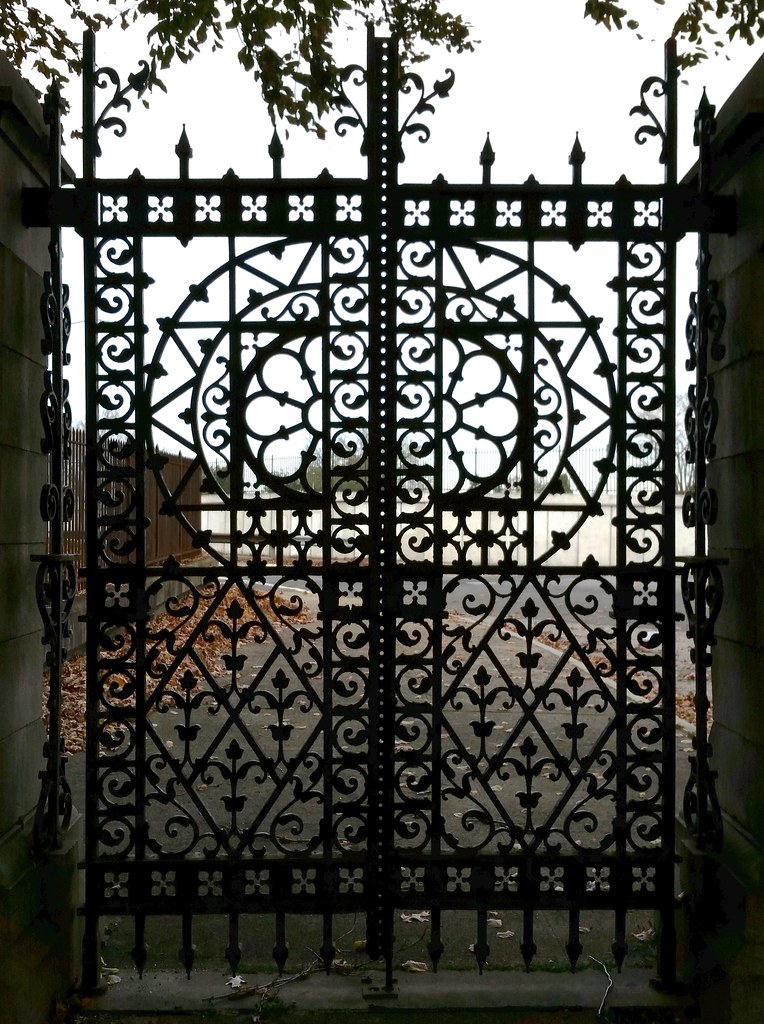
Starting in the 1850s, to meet the needs of its rapidly growing population, the then-independent city of Brooklyn constructed the Ridgewood Reservoir (old photos) just over the county line in Queens, atop the Harbor Hill Moraine in what is now Highland Park, and built an aqueduct system to supply it with water from a series of dammed streams and wells located farther east on Long Island, in today's Queens and Nassau Counties. (As we recently learned, the water flowed west through the eponymous conduits of Conduit Avenue/Boulevard and was pumped up to the reservoir through the eponymous force tubes of Force Tube Avenue.) Over time, more water sources were incorporated into the system, and the reservoir grew as well: a third basin was completed in 1891, doubling the total capacity to some 300 million gallons.
Brooklyn became part of New York City in 1898. With the development of the city's two vast Catskill Mountain aqueduct systems (the Catskill and Delaware Aqueducts) in the early and mid-1900s, the Long Island water supply became less and less important. The water from the Catskills, in addition to being much more plentiful, was also cheaper to transport: unlike the Long Island water, which required pumping, it originated at a high enough elevation to reach the city under the force of gravity alone. Thus, the Long Island water was used only when the city's demand exceeded the capacity of its gravity-powered upstate aqueducts (the Catskill systems plus the older Croton and Bronx/Byram systems). The Ridgewood Reservoir, while maintaining its connection to the Long Island supply, also began receiving Catskill water. It continued to function as a distributing reservoir until about 1959, after which it was used only as a backup supply. It was finally taken out of service altogether sometime around 1985 or 1989.
Over the years, the reservoir's three basins, covering some 50 acres, have been slowly reclaimed by nature.* The center basin, above, contains a pond surrounded by phragmites, the invasive, ubiquitous reed found in wetlands all over the city. The east and west basins, on the other hand, are "filled and completely vegetated", and are home to "closed forest, scrub, woodland, and vineland" habitats, according to the Parks Department. For more specifics, check out this detailed survey of plant life in the reservoir.
In 2007, it came out that the Parks Department was leaning toward leveling the forest in the largest (west) basin and building new athletic fields there. This caused an uproar among environmentalists and many local residents, who argued that the reservoir's wildness is a precious resource that needs to be preserved and that Parks should renovate the existing ball fields in the adjacent areas of Highland Park instead of building new ones inside the reservoir. After taking a tour of the reservoir in 2008 and seeing its charms firsthand, Bill Thompson, then the city's comptroller, co-authored an NY Times op-ed arguing against the destruction of the forest, and, a month later, rejected a Parks Department contract to build athletic fields in the basin.
In 2009, Thompson approved a contract to fix up the walking paths and other perimeter features at the reservoir, work that was completed in October 2013. The contract also specified that three conceptual plans for the overall development of the reservoir, including one design for passive recreation, would have to be created and submitted to the public for feedback before the project could go ahead. Although there's currently no funding lined up for future work at the reservoir, the three designs were presented to the public in June 2013. To describe them briefly: one would allow access only to the west basin, where walking trails would be built; one would provide for light recreation in each basin; and one would involve the additional construction of baseball fields, a comfort station, and a "waterworks-themed adventure playground" in the west basin.
Just this past summer, it looked like the reservoir was facing another threat from the Parks Department. Parks officials were talking about starting work by August on a $6 million project that would involve breaching the inner and outer walls of the reservoir in order to install culverts. Additionally, a gravel roadway would be built between the three culverts for construction and maintenance vehicles to use. The purpose of this work was to bring the reservoir into compliance with State Department of Environmental Conservation (DEC) regulations (although some suspected that Parks might be going through with the project as a sly way to lay the groundwork for future development of the reservoir). Basically, the DEC has classified the reservoir as a Class "C" or "High Hazard" dam. The city obviously doesn't want to have to maintain a defunct reservoir as if it were an active dam, so it needs to get the reservoir reclassified as a Class "A"/"Low Hazard" or Class "D"/"Negligible or No Hazard" dam. The culverts would lower the hazard level by allowing any water that gathers in the reservoir to flow out before it reaches a potentially dangerous volume.
Of course, a much simpler way to get the reservoir reclassified would be to ask the DEC to change its classification. But would that be appropriate in this case? Well, the state defines a high hazard dam as a dam whose failure "may result in widespread or serious damage to home(s); damage to main highways, industrial or commercial buildings, railroads, and/or important utilities, including water supply, sewage treatment, fuel, power, cable or telephone infrastructure; or substantial environmental damage; such that the loss of human life or widespread substantial economic loss is likely."
If that strikes you as a ridiculous description of a mostly empty reservoir, you're not alone. But it was only after community members and elected officials raised a ruckus that Parks decided to hold off on the culvert plan and apply to the DEC for reclassification instead. As far as I know, nothing's been approved yet, but the DEC commissioner seemed amenable to the idea in a letter to the aforementioned elected officials.
* It's difficult to tell when each of the basins was abandoned. In my research, I repeatedly came across the claim that only one of the three basins was used during the reservoir's final, post-1959 role as a backup supply, but this is clearly contradicted by some historical aerial photos I found using the USGS's EarthExplorer. Judging from what I see in the photos, the center and west basins were both kept full until at least 1976. By 1984, the west basin looks to have been abandoned and to have started its transition to a more natural state. The center basin still appears to be in use in 1985, but the phragmites invasion was underway by 1994. It looks like the east basin hasn't been used since at least 1959, and so presumably started growing wild much earlier than the other two basins. Just for the sake of thoroughness, and to put everything in one place, here are the relevant aerial photos I was looking at:
- February 18, 1954: All three basins are full.
- October 30, 1959: From this point on, the east basin looks abandoned in every photo. It contains water at times, but is never full.
- April 29, 1960
- May 5, 1960
- February 23, 1966
- September 15, 1969
- September 23, 1972
- August 30, 1976
- October 29, 1976
- March 26, 1984: The west basin now appears abandoned.
- March 16, 1985
- April 4, 1994: Phragmites can be seen in the center basin. This is the earliest photo I can find in which all three basins are abandoned.
If you're still reading this, you might also be interested in viewing the city's high-resolution aerial images of the reservoir over the years: 1924, 1951, 1996, 2006, 2008, 2010, and 2012.

of the Ridgewood Reservoir. Here's the description of this section of the basin from a 2005 Parks Department survey of the reservoir:
Black locust and mugwort dominate throughout this area. Other species found are: buckthorn, Phragmites, goldenrod, bush honeysuckle, bigtooth aspen, grey birch, quaking aspen, Royal Paulownia, Japanese knotweed, white snakeroot, smartweed, poison ivy, bittersweet nightshade, oriental bittersweet, and cottonwood. A great deal of bird activity was observed in this unit.
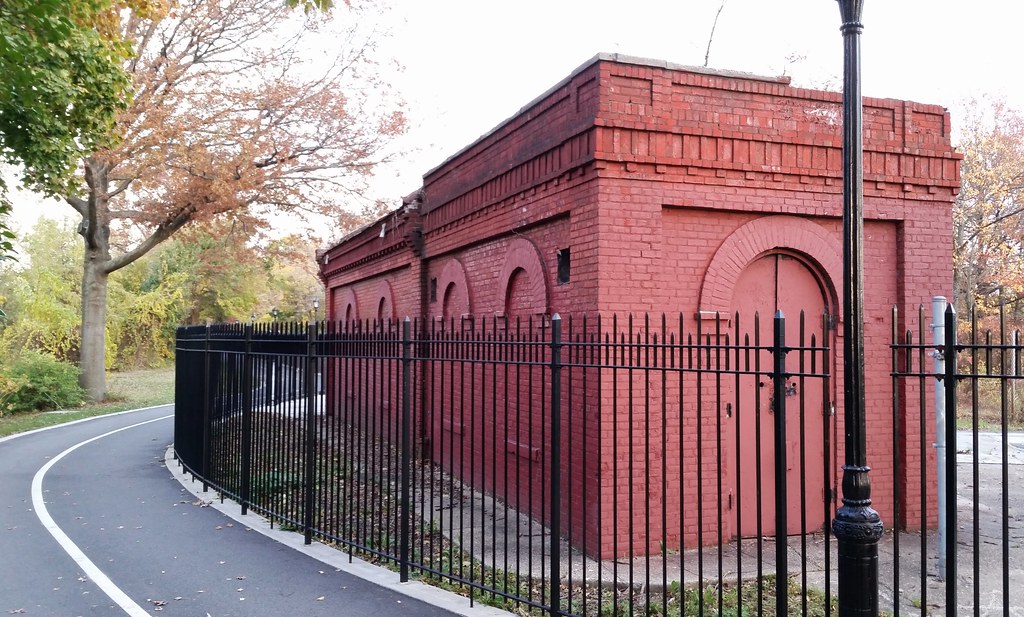
Located at the northern end of the Ridgewood Reservoir, between the two original basins that went into operation in 1858, this building stands atop the sluice gates that controlled the amount of water leaving those basins. The water would pass through the sluices into an effluent chamber, where it would enter the pipes of the distribution system and be carried down to the people of Brooklyn.
From Brooklyn Water Works and Sewers: A Descriptive Memoir, written by the chief engineer in charge of the reservoir's construction:
The water space of the effluent chamber is connected by passages eleven feet wide, with the two divisions of the reservoir. A heavy granite wall is built across each passage, rising to the same level as the top of the reservoir banks. In each wall there are four openings, the two lower openings being 3x3 each, and the two upper openings 3x4 each. Iron sluices running in iron slides, faced with composition metal, cover and control these openings. From these sluices, iron rods of two inches diameter rise to the top of the work, where they terminate in screws and gearing for the movement of these sluices. [Two hand-wheels for controlling the sluice gates can still be found behind the gatehouse.] . . .
In front of the sluices, towards the reservoir, in each passage, copper wire screens are placed, twenty-two feet in height, to prevent fish, leaves, &c., from passing into the effluent chamber, and so into the supply pipes. . . .
The apparatus for moving the sluices is protected by a small house built over each passage.

Three Obama-inspired business names in one day? (Here are the other two.) Prior to today, during the entire course of this walking project, I had only come across three other establishments named for our current president. (I previously said I had only come across two, but I had forgotten about the most explicit one of all.) Obama Deli & Grill had already either been renamed or gone out of business when I passed by. Obama Fried Chicken has gone out of business since I passed by. And Barack Hussein Obama Children Center, it seems*, may never have gone into business in the first place (although its awning was still up when the Street View car drove by in October). So it's entirely possible that most or even all of the active businesses in the city named for the president are located here in Cypress Hills, on or just off of Fulton Street, within seven blocks of each other. Weird!
(FYI, King Barack opened up shop sometime between August 2011 and September 2013.)
* The NY Post article linked above makes Sheikh Moussa Drammeh ("Sheikh" is his first name, not a title, and is misspelled in that article), a Bronx imam, sound like a sleazeball and/or nutcase.** But from what I've read, he's a well-respected, positive force in his community of Parkchester. In fact, the Post itself honored him with one of its annual Liberty Medals back in 2007. He founded the Islamic Leadership School — the Bronx's only Islamic school — which, in a bizarre coincidence, opened on September 11, 2001. His latest community venture is a neighborhood "peace patrol" that aims to help troubled kids before they turn to crime.
He's also twice been in the news for his generosity to other religious organizations. In 2004, when the Interfaith Center of New York, led by a former dean of the Cathedral of St. John the Divine, was unable to make rent on the Midtown Manhattan space it had called home for five years, Mr. Drammeh gave the group office space in the Bronx free of charge, in the same building that's now home to, among other things, his mosque, his school, and the apparently never-opened Barack Hussein Obama Children Center.
In 2008, when a tiny, aging Jewish congregation in the neighborhood found itself without a home, Mr. Drammeh offered up space in his mosque, rent-free, saying "I’m paying back. I am an immigrant, from Africa. I came here to New York and all the religious freedoms and acceptance, I don’t have to fight for it, the Catholic and Jewish communities already fought, and now it’s for my behalf. It would be very ungrateful if I don’t play any role, especially for the older folk, so they can benefit in turn from my being here. It is my time to say, let me [pay back] at least a little bit for the neighborhood you made and the work you have done." As far as I can tell, the congregation is still in existence and is still meeting in the mosque.
There's also a pedestrian aspect to this story. When the congregation was on the brink of collapse, shortly before Mr. Drammeh's offer, it was taken over by young Chabad rabbis and rabbinical students who had responded to the elderly Jews' requests for help. Forbidden from traveling by motorized vehicle or bicycle on the Sabbath, the Chabadniks began regularly walking the 15 miles from their homes in Crown Heights, Brooklyn to the mosque on Saturday mornings to lead services. (Nerd note: the route mentioned in the article is over 16 miles long.)
** I should note that the Post was correct about Mr. Drammeh inventing what it called a bathroom-sink alarm. In 2013, he was issued US Patent No: 8,344,893 for a "hygienic assurance system" that uses a "plurality of sensors" and a "plurality of visual and audible signals", as well as a camera, to remind people (presumably employees) to wash their hands after using the toilet and to ensure that those who don't wash up properly, "for an adequate time span", can be identified "for later reprimanding . . . by the facilities owner or hygiene enforcer." But I have some good news for those of you who hate washing your hands. I've looked over the patent and found a loophole. Flushing is the action that triggers the system into thinking you need to wash up, so all you have to do is not flush!
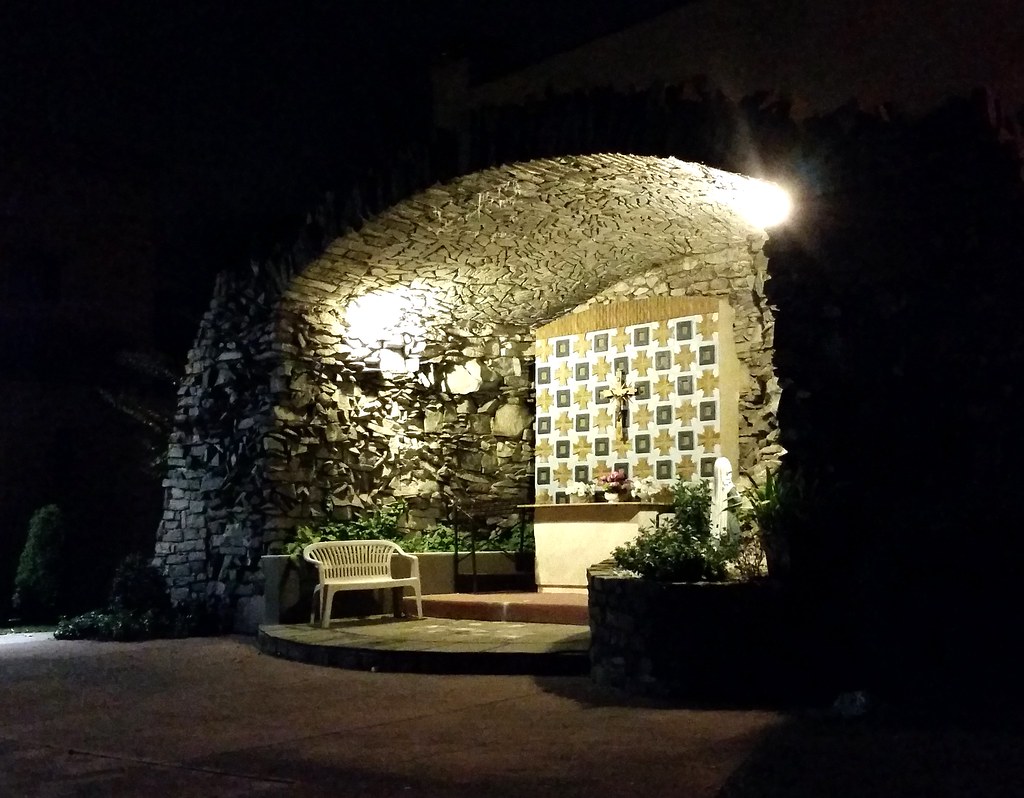
at the Church of St. Sylvester. Check it out in the daylight.
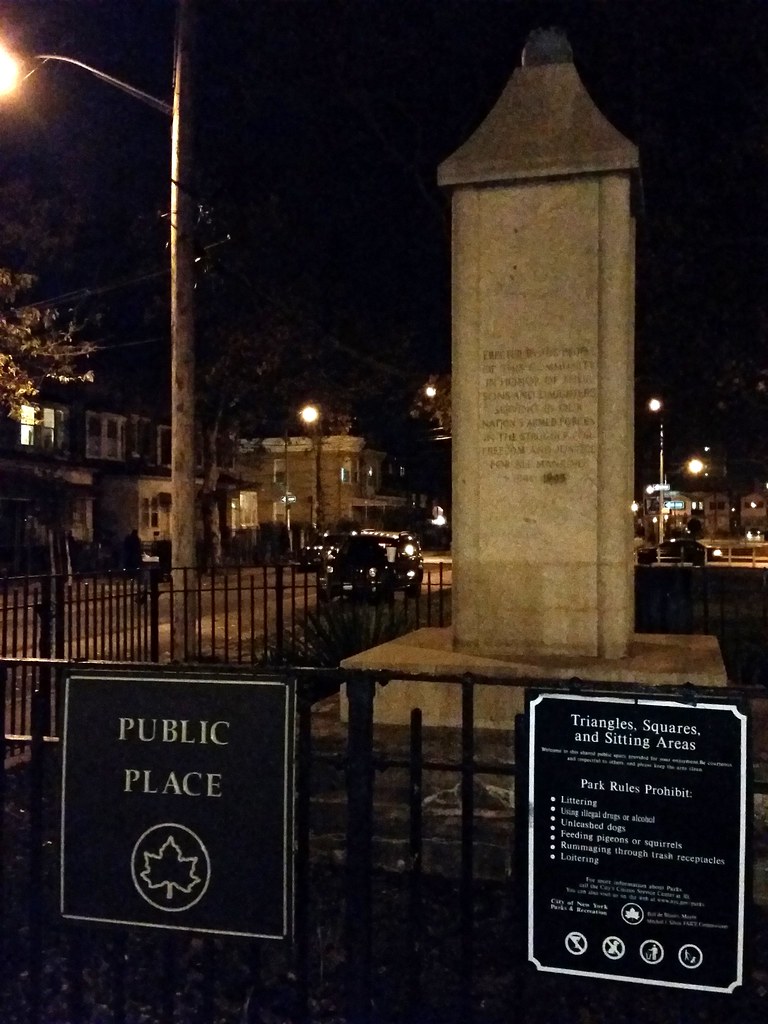
This little parklet looks much more welcoming than the last such Place we saw. Apparently, there was originally a bronze eagle on the World War II memorial above. It must have been either stolen or damaged, but I'm guessing those are its talons still perched atop the monument.
(The wildly imaginative name of this public place brings to mind the string of Parks found along the Prospect Expressway.)
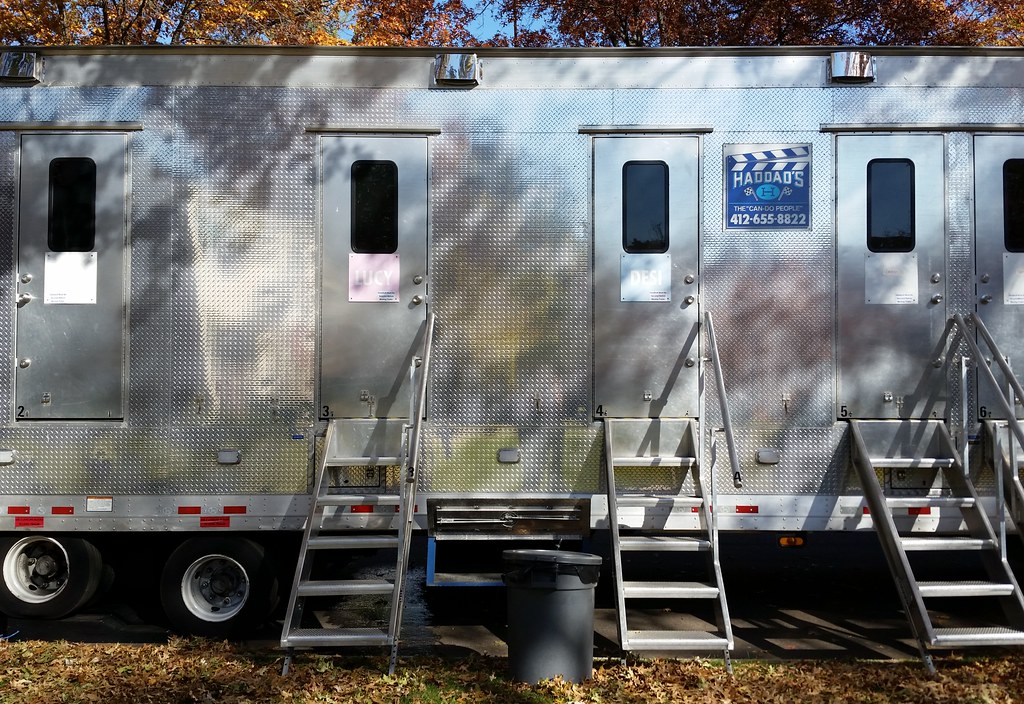
Lucy and Desi? Turns out they're discreetly labeled bathrooms!

Various signs in the area let me know that Law & Order: SVU was shooting here in Bay Terrace today, which explains the trailer in the previous photo (and which gives the Lucy/Desi labels a little extra resonance, since one of the actors on the show, Danny Pino, played Desi Arnaz in a TV movie about Lucille Ball).
Down the block from the filming, I passed by a woman in her 40s camped out on her stoop, smoking a cigarette. "I wanna see Ice-T!" she informed me. "Ice-T? I thought he was on some other cop show," I replied. "Well I wanna see someone famous!" she shot back. I'm not sure how deep her devotion to the cause was, however. With a slight amount of effort, she could have dramatically increased her odds by standing up and walking over toward the action, where any famous people in the vicinity would surely be found (and where a small group of curious neighbors had already congregated).
She was right about Ice-T, though, as I found out a minute later. That's him about to cross the street above (zoom in).

In grateful recognition of the gift by Sara Willets Meyer of the land on which this bridge and a portion of the Belt Parkway have been built — Anno Domini MCMXXXIX
Sara(h) Willets Meyer was the last member of the Willets clan to live in the grand mansion, no longer standing, that her grandfather built here in Bayside around 1850. The plaque above indicates that she donated a strip of land from the family estate for the construction of a piece of the Cross Island Parkway, which was being built as part of the larger Belt Parkway project when she died in 1939.
At about 36 miles in length, the Belt extends more than halfway around the perimeter of Brooklyn and Queens. It comprises four different sections, each with a different name: Shore Parkway, Southern Parkway, Laurelton Parkway, and Cross Island Parkway. On road signs, for whatever reason, the Cross Island is labeled as a separate entity, while the other three sections all get lumped together under the Belt moniker.
During its planning stages, the Belt was known as the Circumferential Parkway. Its present name was selected from among a wealth of options near the end of 1938, according to a Brooklyn Daily Eagle article from December 20, 1938:
At least one of the two major puzzles baffling the public has been solved.Pshhh. Tortuosity would have never stopped Henry Stern!
Nobody knows yet who's going to be Scarlett O'Hara in the film version of "Gone With the Wind" but Park Commissioner Robert Moses has settled the controversy raging over the renaming of the Circumferential Parkway . . .
From now on, he said yesterday, the $28,000,000 project will be known as the Belt Parkway, largely as a concession to those who, like Queens Borough President Harvey, asserted their inability to spell or pronounce its temporary title.
Commissioner Moses decided to act after numerous suggestions had poured into his office, among them Ringstrasse Parkway, submitted by Mayor LaGuardia. One suggestion which Moses cherished until the last was Lynque Parkway, which combined the last three letters of Brooklyn with the first three of Queens. He finally decided it sounded too tortuous.

Compare to the fishin' scene on the west side of the Throgs Neck Bridge (the bridge you see above).
Throgs Neck, or Throggs Neck, is the section of the Bronx at the other end of the bridge. According to the NY Times: "The name derives from John Throckmorton, an Anabaptist from England who had lived in Rhode Island before he established a small settlement in 1642 in what is now the southeastern corner of the Bronx."

This sign stands at the western edge of Little Bay Park, across from the wealthy residential section of Whitestone known as Robinwood. The neighborhood's name comes from the real estate development of Robinwood/Robin Wood/Robinswood, which began taking shape in the 1920s on a piece of waterfront property that was supposedly once owned by Francis Lewis, a signer of the Declaration of Independence.

to the 167th Street pedestrian bridge over the LIRR's Port Washington Branch
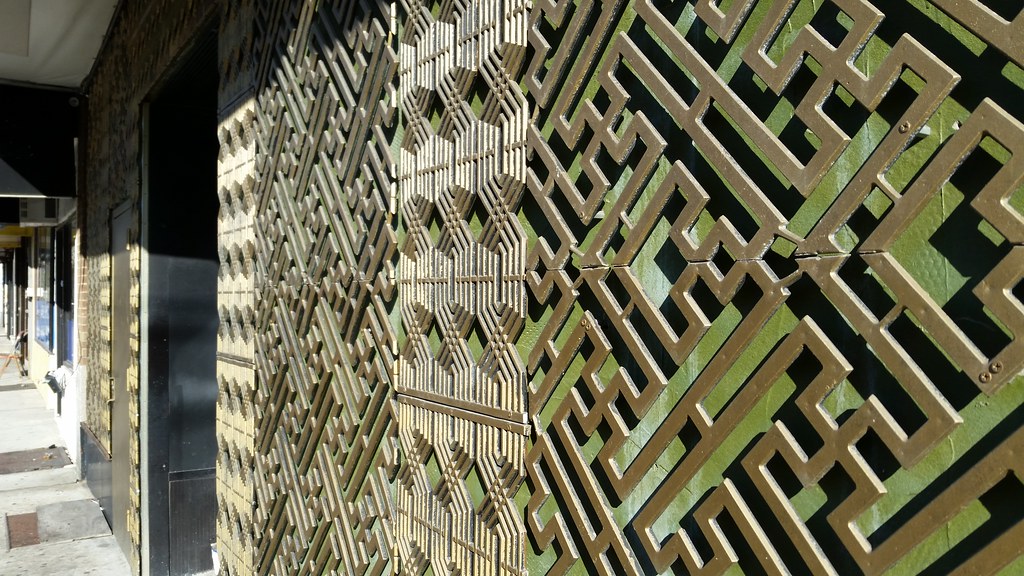
of Sapphire X Business Club/Karaoke. As you can see, the same patterns can also be found next door at the Mona Lisa Room Cafe.

and it's not even Thanksgiving! We were here once before, in early January of 2013; you can compare that scene to this one. And you can see video of the house at night here. In between our visits, the house's owners, the Lynch family, won $50,000 on the first episode of The Great Christmas Light Fight.
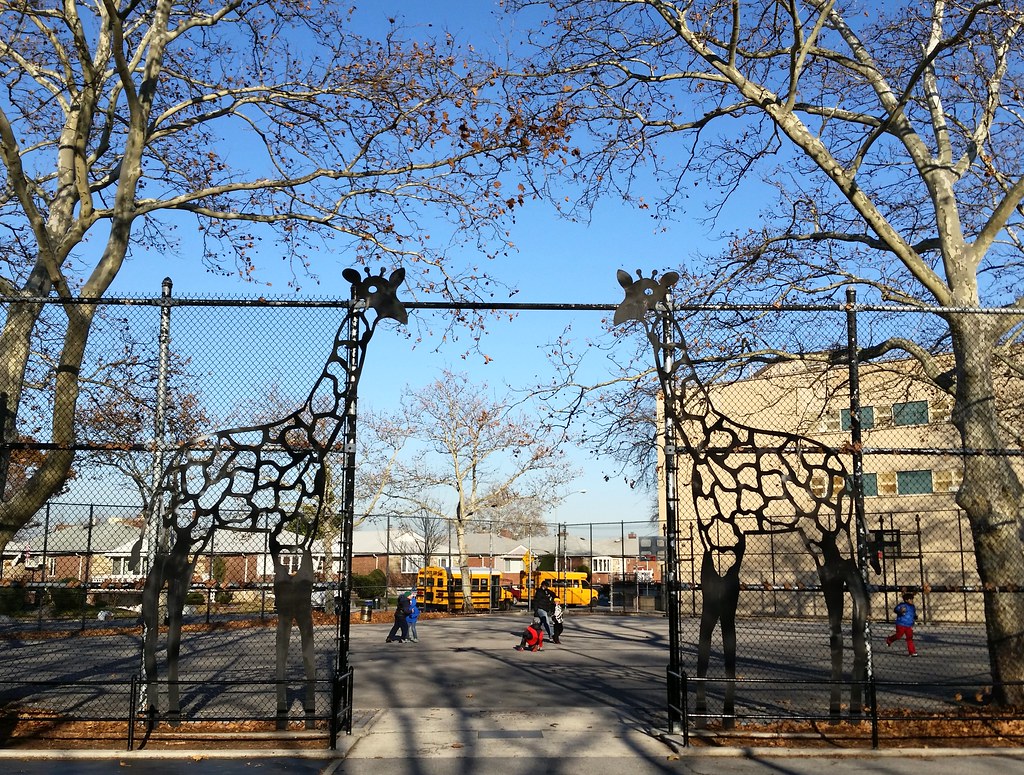
at Willets Point Playground. The Willets Point that this playground is named for, the home of Fort Totten (photos), is not to be confused with Queens's other Willets Point, the otherworldly, soon(ish)-to-be-redeveloped Iron Triangle.

Following a rough winter, 2014 has been a dismal year for NYC's normally bountiful fig trees. You could count the ripe figs I've seen this year on one hand, even if you're missing a finger or two.
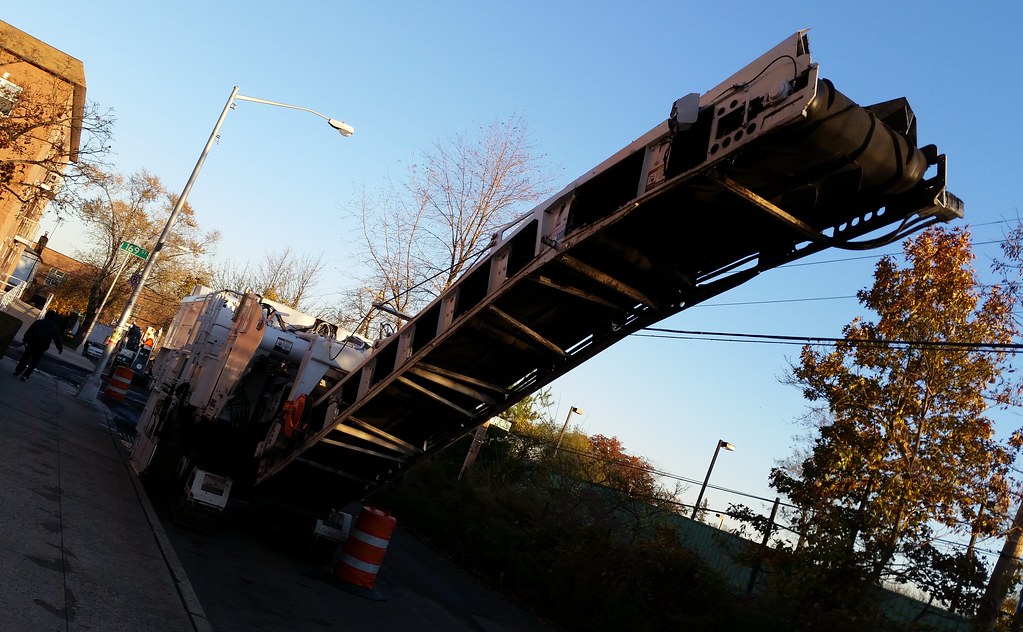
Machines like this Roadtec RX-700e (a.k.a. De-Roadinator 1000s) are used to remove pavement from a roadway before it is resurfaced. Here's one in action.
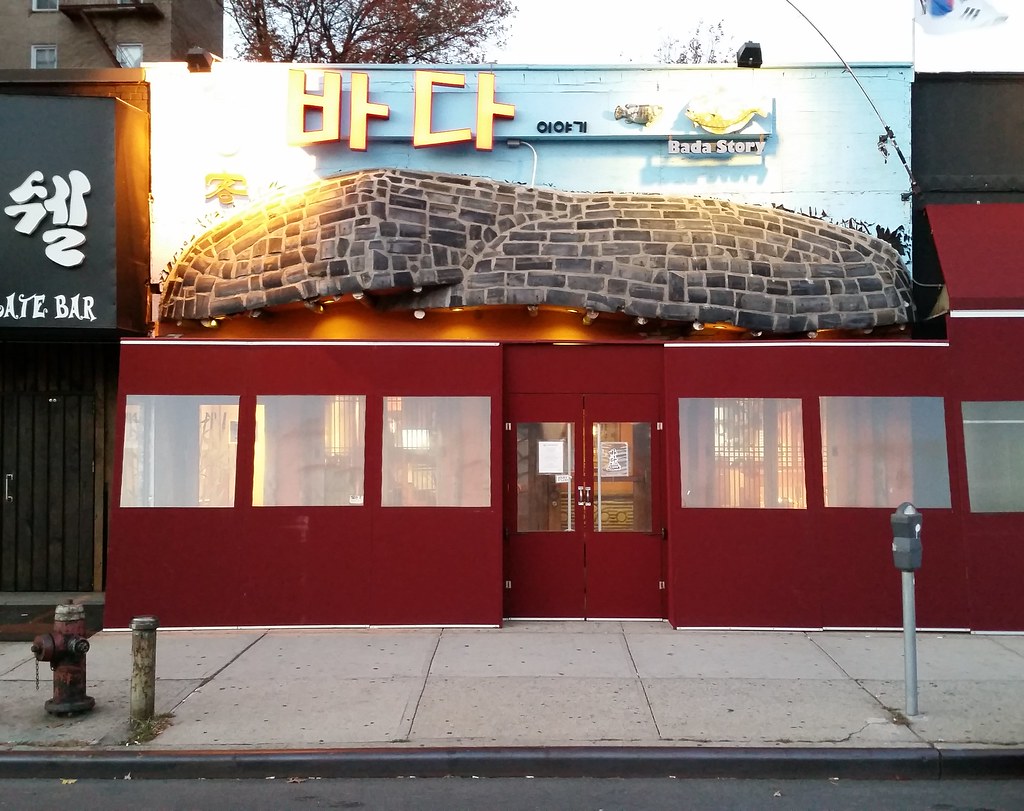
From an NY Times article about Korean Restaurants in Queens:
A Bada Story feast (bring a crowd) might start with some excellent fried fingers of fish and a first-rate seafood pancake, then move on to a tableau of marine life not seen on the sashimi special at your corner sushi bar: chewy sea squirts with their wrinkled orange skin; strips of sea cucumber that unfurl like streamers from your chopsticks but tense up again when you bite down; sea worms that look like veins and taste like not very much but have chewiness to spare. Then, in a swirl of mist, arrives a whole imported Korean fluke that a few minutes ago was lounging at the bottom of a pool by the kitchen. The slices, draped over frosty ceramic cups to keep them firm, are arranged as they were on the skeleton, with the lightly crunchy hard-working muscles around the fins showcased at the edge of the platter.Photos here.
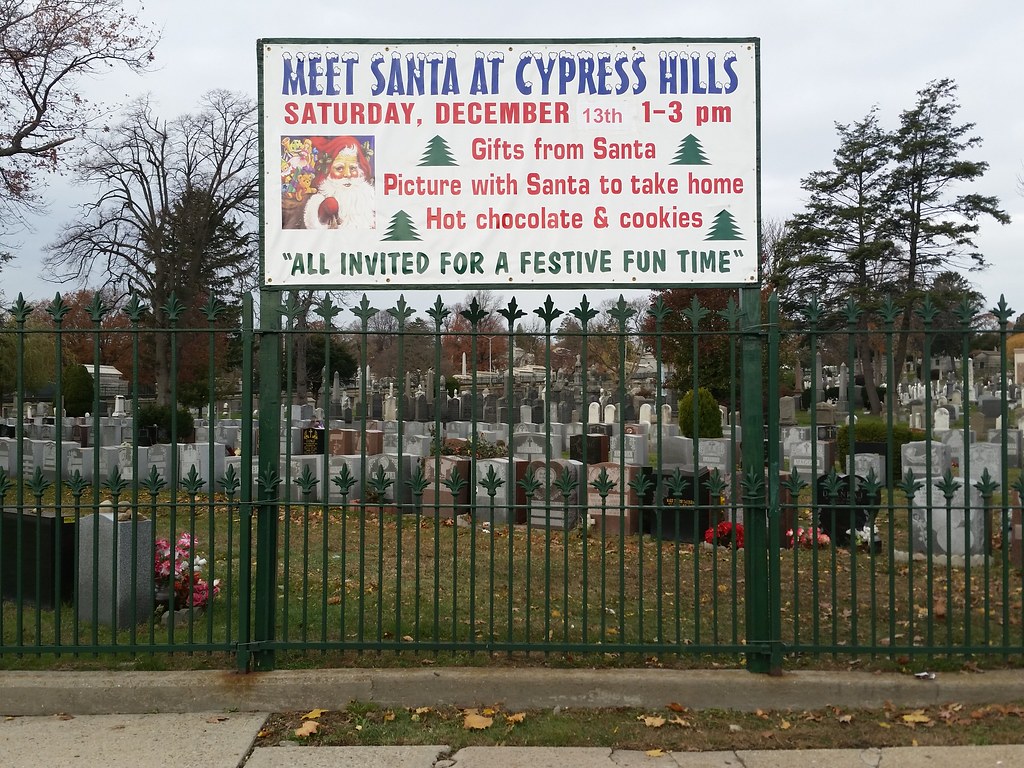
at Cypress Hills? I love a good cemetery as much as anybody, but this seems like a bizarre place to take the kids for a Santa meet-and-greet.
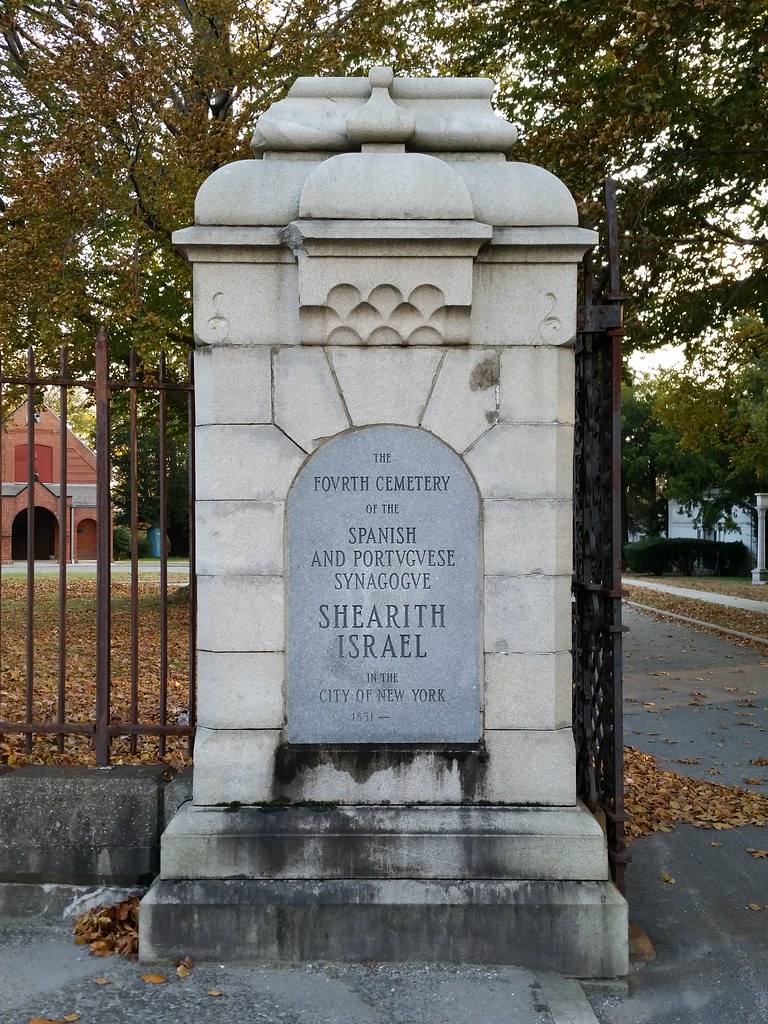
Beth Olom consists of burial areas for three different synagogues: Shearith Israel, B’nai Jeshurun, and Shaaray Tefila. Shearith Israel, founded in 1654, was the first Jewish congregation in North America and the only one in New York City until 1825, when some of its members left to form B’nai Jeshurun. Shaaray Tefila split off from B’nai Jeshurun in 1845.
As you can see above, the Shearith Israel portion of Beth Olom is known as the synagogue's fourth cemetery. We've already seen its first, second, and third cemeteries in Manhattan. (The congregation may have had an earlier cemetery that predated even the "first" one: in 1656, the city's Jewish community was granted permission to use "a little hook of land situate outside of this city for a burial place", but there is no definite record of this burial ground's establishment or location.)
In what I would imagine was just a weird coincidence, I once walked past this cemetery — the final resting place of Emma Lazarus — and found that someone had left a large statue of the beggar Lazarus and two of his canine companions standing outside the gate.

From atop the Harbor Hill Moraine at the edge of Beth Olom Cemetery, I'm looking down at Salem Fields Cemetery and out onto the outwash plain of southern Brooklyn and Queens.
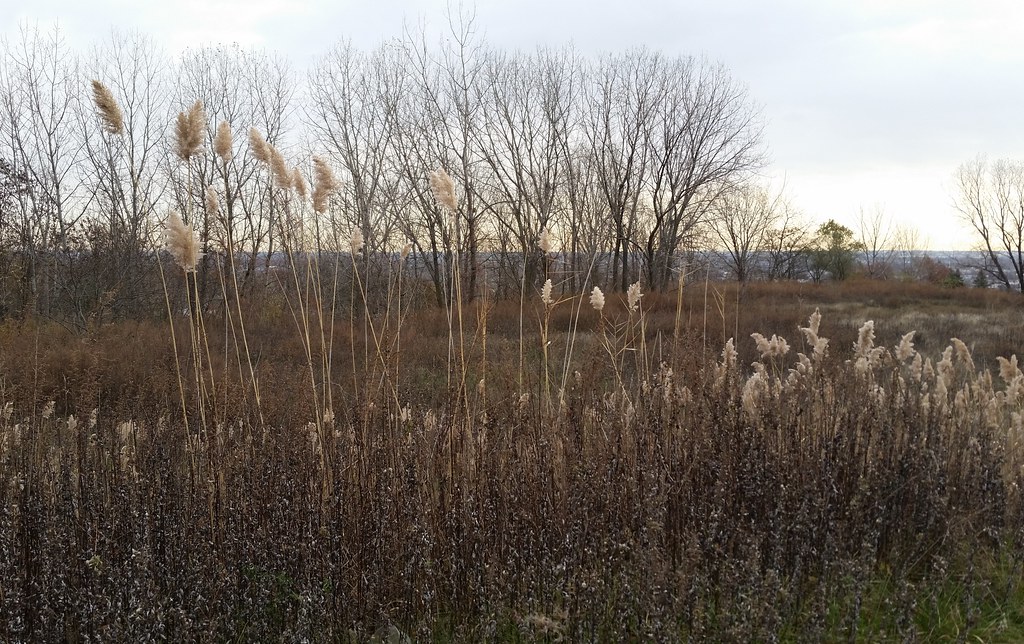
This steep-sided, flat-topped, unnatural-looking hill rises abruptly just beyond the western edge of Beth Olom Cemetery. Standing above the surrounding sea of burial grounds and the neighboring Ridgewood Reservoir, it's a very curious sight — the only piece of land in the vicinity that's not part of a cemetery or park.
It turns out that for about half a century, starting around 1877, this property was home to a privately run recreation area known as Cypress Hills Park. It was owned by the Banzer family but had different proprietors over the years, and so was also at times called Banzer's, Wissel's, Bookman's, Richter's, or Gerken's Park. A large U-shaped pond, used by boaters in the summer and ice skaters in the winter, was the dominant feature of the site (1924 aerial view), which also contained, by 1891, a pavilion, a bandstand, a dining room, four bowling alleys, and some popular shooting ranges where "some of the best rifle shots in the United States . . . [had] their regular practice days". (You can see old photos of the place here; scroll down about halfway.) The park's days came to an end around 1928, when the Banzers sold the land to its present owner, Temple Emanu-El, the Jewish congregation that also owns the adjacent Salem Fields Cemetery.
The pond was filled in sometime before 1951, although at least part of it still existed in 1937 when a 13-year-old boy drowned in it, an incident that prompted the boy's father to sue the synagogue. Over the years, it appears that Emanu-El used the site as a dumping ground for dirt and rocks — including, perhaps, some excavated material from the cemetery and/or other nearby cemeteries? — forming the hill that now stands here. An aerial view from 1996 shows a largely barren landscape with a path running up the hill, presumably for trucks and earth-moving equipment, while subsequent images from the past decade (2006, 2008, 2010, 2012) show trees springing up and the dirt paths gradually becoming overgrown.

The artificial hill on the former site of Banzer's Cypress Hills Park stands high above even the upper section of Cypress Hills National Cemetery.
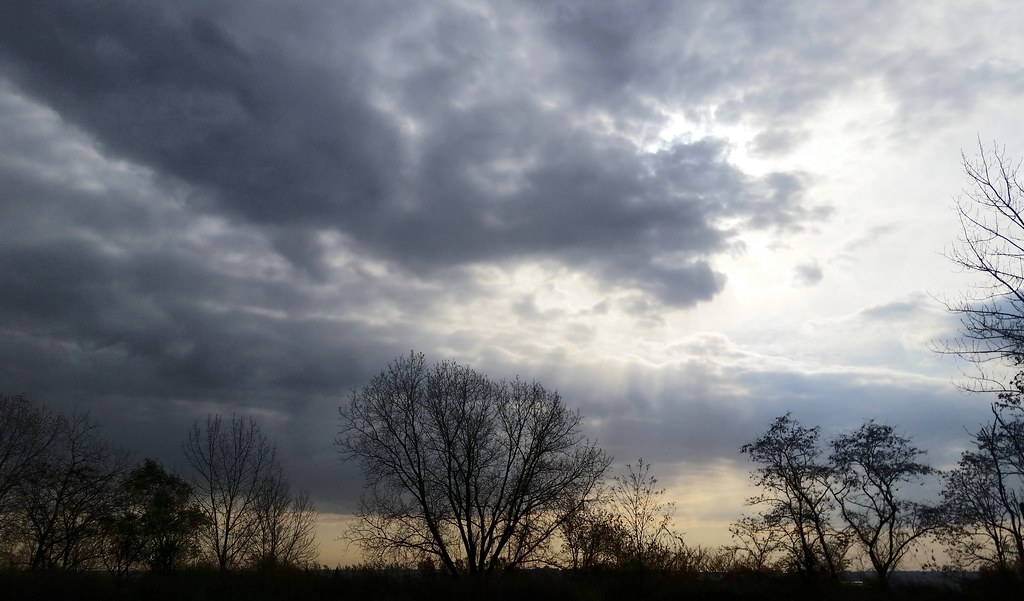
Here's one more shot from the artificial hill that stands on the former site of Banzer's Cypress Hills Park. While researching the park, I discovered that there used to be a Brooklyn neighborhood called Picklesville in the area of East Williamsburg/Bushwick. Some highlights from my subsequent quest for information about Picklesville:
- A Brooklyn Daily Eagle article from May 30, 1936, entitled "A Lot of Bologna, Indeed, Comes Out of Long Island in the Course of a Year—and the Whole World Eats It, Thick or Thin", part of a larger tribute to the industries of Long Island:
Shortly before the turn of the century, the vicinity of Morgan Ave. and Rock St. was decidedly a rural section. The inhabitants who were mostly of German descent lived in trim bungalows along the tree-lined, level dirt streets. The chief activity of these German farmers was the raising of pickles for nearby metropolitan market, and consequently the neighborhood earned the appropriate if inelegant title of "Picklesville."
- An NY Times article from October 5, 1883, entitled "Two Irate Picklesvillians — True Love Pursuing the Traditional Erratic Course":
Far over in the wilds of Brooklyn, away from the strife and turmoil of the city, is the little suburb of Picklesville . . . So rural is this place that no cars run through its quiet streets, beer saloons are infrequent, and the belated Picklesvillian going home from his business in the city at 9 o'clock at night discovers no signs of life in the deserted thoroughfares, save as the night-winds convey to his ears the tuneful breathing of the sleeping inhabitants. Even into so quiet a community as this, however, trouble may enter and dissensions lead to seemly squabbles. Within a week a scandal has arisen which has convulsed the entire district of Picklesville.
- A Brooklyn Daily Eagle article from February 2, 1890, entitled "Dogs of War Let Loose — Hostilities Renewed Between Picklesville and Elm Street":
The casus belli is a question of territorial rights, the boys of Picklesville claiming that Picklesville includes the easterly side of Knickerbocker avenue and the Elm street men claiming that both sides of the street are included in their domain. The armies yesterday, equally matched, numbered about two thousand; the Picklesville forces, two divisions, under command of General John Seid, of 102 Central avenue, aged 17, and the Elm street forces, two divisions, under General Charles Engelhoffer, of 195 Ellery street, aged 11 years. Johnny Schneider, aged 13, commanded the right wing of the Picklesville forces and went early into action, or was rather drawn into it by the capture of all his pickets by Lieutenant Colonel Epaminondas Schwakhammer, aged 13, in command of the Elm street band of skirmishers. . . . General Seid, seeing that Schneider's command was in danger of being cut off and attacked in detail, dispatched his aide de camp, Diedrich Finnegan, with an order to fall back on the sand bank known as the Eagle's Nest, back of the Manhattan Avenue Railroad, beyond Irving avenue. On his way the aide de camp was struck with a tomato can, knocked down, taken prisoner, and the order fell into the hands of the enemy. The result foreseen by General Seid then took place. Schneider's command was cut off and most of them, after a terrible resistance, laid down their arms. While Seid with the main body of his forces was pressing on the cry of "Police" was raised, and the form of Officer John Ruoff looming up in the distance like Gulliver, the Liliputian [sic] armies became instantly a rabble rout.
- A Brooklyn Daily Eagle article from December 22, 1890, entitled "War on the City Frontier — It Is Brought to a Close by the Intervention of a Third Power":
The war has been a protracted one, dating back over a year, the casus belli being the north side of Knickerbocker avenue . . . The contending forces came within sight of each other on Knickerbocker avenue, between Starr street and DeKalb avenue. The Picklesvillers, halting, were addressed by General Sauerbrod from the roof of a grocery coal bin. He said:
"Men of Picklesville—I do not expect that words from me can impart valor to anyone who lacks it. The enemy is before us, but let the recollections of memorable deeds done by men of Picklesville in the past stimulate you to the achievement of greater things this day. Soldiers, from the cupola of yonder brewery twenty years look down upon you." . . .
[After several of the boys were arrested and locked up for the night,] Justice Goetting this morning seemed at first determined to send the prisoners to the Fortress of Refuge till they were 21 years old, but finally let them off with a fine of $5 each.

The first Jewish commodore in the US Navy, Uriah Phillips Levy was a key figure in the push to abolish flogging — or "the barbarous practice of corporal punishment", as his grave monument puts it — in the Navy. (He was, however, once court-martialed for "scandalous and cruel conduct" for his implementation of an alternative punishment for a teenage boy on his ship who "was charged with mimicking an officer of the ship. Unwilling to flog the boy, Levy ordered him tied to a gun with his trousers lowered. A small quantity of tar, variously described as the size of a silver dollar to the size of a man's head, was applied with oakum to his buttocks along with some parrot feathers.")
Levy is best remembered for his role in saving Thomas Jefferson's Monticello. When he arranged to purchase the property from James Turner Barclay in 1834, eight years after Jefferson's death, the place was in a sorry state. Jefferson had been unable to afford upkeep on the house in his later years, and Barclay, a local druggist with "a hare-brained scheme of turning Monticello into a silkworm farm", allowed things to fall further into decline.
A great admirer of Jefferson*, Levy gathered "a small army" of hired workers and slaves to bring the house back to its former glory. In his will, he offered the property to the federal government for use as a farm school for children of deceased naval warrant officers. Shortly before his death in 1862, however, Monticello was seized by the Confederacy. The federal government did not accept Levy's bequest of the property, and his will was declared invalid in 1865, leaving the place in a state of legal limbo after the Civil War.
By the time Uriah's nephew Jefferson Monroe Levy gained control of the property in 1879 following a lengthy period of litigation, it had once again slid into disrepair. It was being used as a working farm, with grain stored in the house and cattle herded into the basement during winter. Like his uncle before him, Jefferson Levy began fixing up the house and grounds, with the intent of restoring them "to the original plans and style". In 1923, the year before his death, he sold Monticello to the Thomas Jefferson Memorial Foundation (now the Thomas Jefferson Foundation), which has maintained it and kept it open to the public ever since.
* In 1834, Uriah Levy presented Congress with a bronze statue of Thomas Jefferson he had commissioned. It was the first full-length portrait statue to be placed in the US Capitol, and is the only statue in the Capitol donated by an individual citizen. Levy gave the plaster model used to create the statue to the City of New York; it currently stands in the chamber of the City Council, where its presence has long been decried by former Councilman and current State Assemblyman Charles Barron, who has described Jefferson as a "white, slave-owning pedophile".
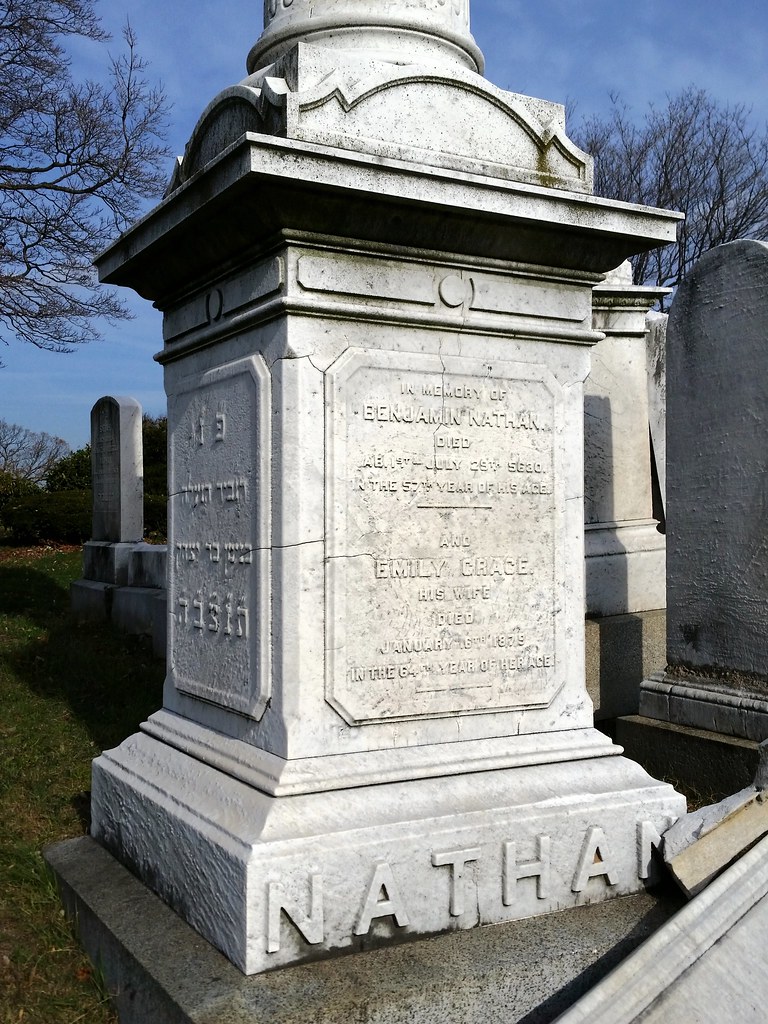
The eponymous uncle of Benjamin Nathan Cardozo was the victim of a sensational, and still unsolved, murder — an assault that was "more atrocious and more shocking than any recent crime" and that left him "marred and mutilated out of semblance to his kind", according to an NY Times article from July 30, 1870, the day after he was killed.
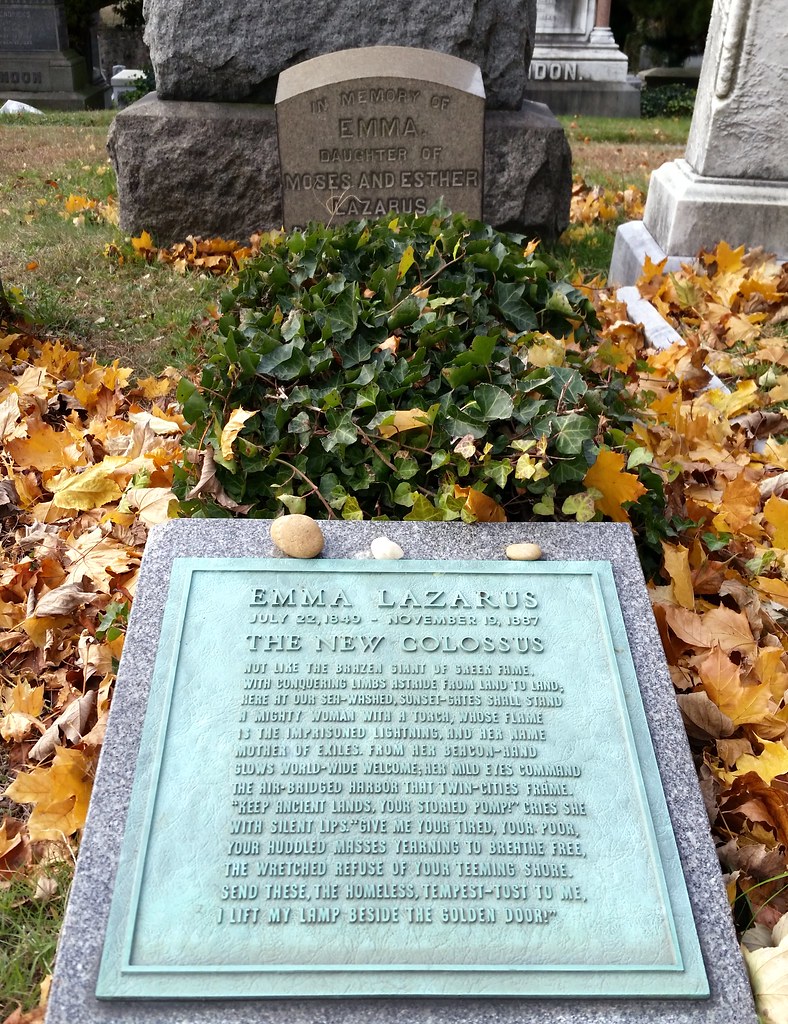
Emma Lazarus (a first cousin of Benjamin Cardozo) was the author of "The New Colossus", the famous poem found inside the pedestal of the Statue of Liberty, which reads in part:
"Keep, ancient lands, your storied pomp!" cries she(The comma after "Keep" is missing from the versions of the poem on Liberty Island and at Ms. Lazarus's grave.)
With silent lips. "Give me your tired, your poor,
Your huddled masses yearning to breathe free,
The wretched refuse of your teeming shore.
Send these, the homeless, tempest-tost to me,
I lift my lamp beside the golden door!"
The statue originally had nothing to do with immigration, however. It was the verses penned by Ms. Lazarus that eventually fixed it in the popular imagination as a beacon welcoming the tired and the poor of foreign lands to New York Harbor.
From the NY Times:
When the Goddess of Liberty was given to the United States, its donor's agenda was to burnish France's republican roots after the oppressive reign of Napoleon III and to celebrate the two nations' commitment to the principles of liberty.
The only immigrants mentioned at the dedication in 1886 were the "illustrious descendants of the French nobility" who fought on behalf of the United States against Britain during the American Revolution.
But it was the words of a fourth-generation American whose father was a wealthy sugar refiner and whose great-great-uncle welcomed George Washington to Newport, R.I., that almost single-handedly transformed the monumental statue in New York Harbor into the "Mother of Exiles" that would symbolically beckon generations of immigrants. . . .
Lazarus's "New Colossus," with its memorable appeal to "give me your tired, your poor," was commissioned for a fund-raising campaign by artists and writers to pay for the statue's pedestal.
But while the poem was critically acclaimed — the poet James Russell Lowell wrote that he liked it "much better than I like the Statue itself" because it "gives its subject a raison d'être which it wanted before quite as much as it wants a pedestal" — it was not even mentioned at the dedication ceremony.
Finally in 1903, after relentless lobbying by a friend of Lazarus who was descended from Alexander Hamilton, himself an immigrant, it was "affixed to the pedestal as an ex post facto inscription," the art historian Marvin Trachtenberg wrote.
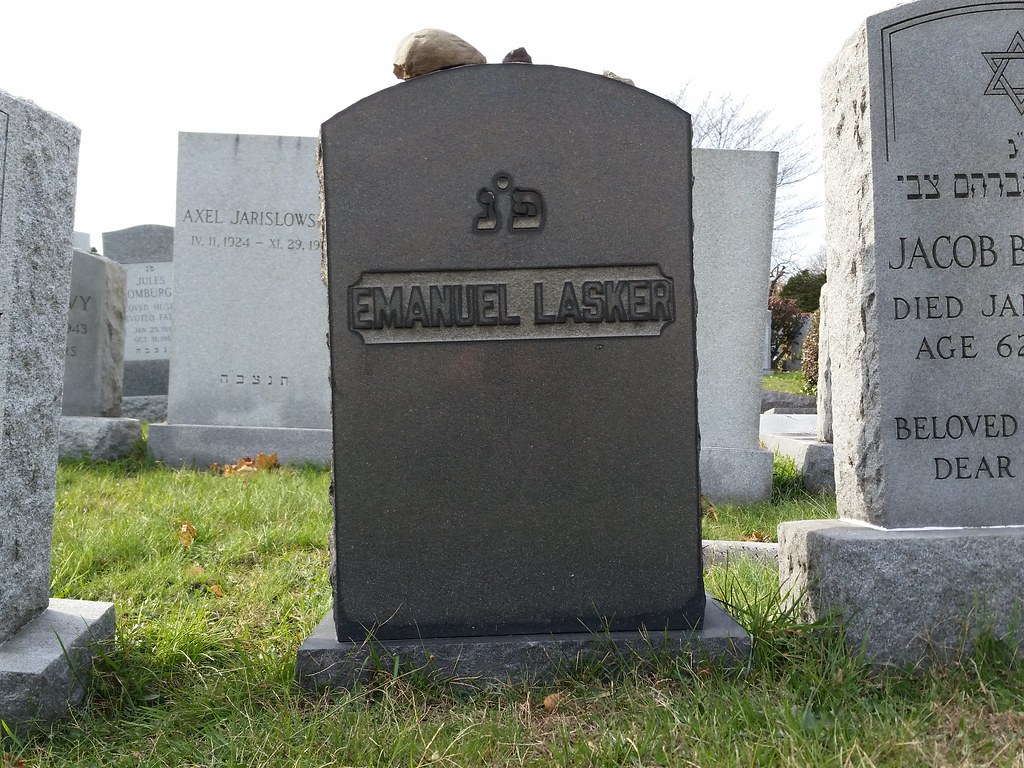
Emanuel Lasker was one of the greatest chess players of all time, winning the world chess championship from William Steinitz in 1894 and holding onto it until 1921.
(As we learned when we saw Steinitz's grave in the Evergreens Cemetery, his 1894 loss to Lasker was the beginning of his mental troubles, at least according to the narrative of his 1900 NY Times obituary, and his defeat in a rematch a couple of years later triggered his rapid decline into insanity.)

We've left Beth Olom Cemetery, crossed the Jackie Robinson Parkway, and entered Hungarian Union Field Cemetery, which is now part of Mount Carmel Cemetery.

The quotation on this gravestone comes from Mark Antony's tribute to Brutus at the end of Shakespeare's Julius Caesar.
(Now we're in Union Field Cemetery, another of the 17 cemeteries clustered together near the middle of the Brooklyn-Queens border.)
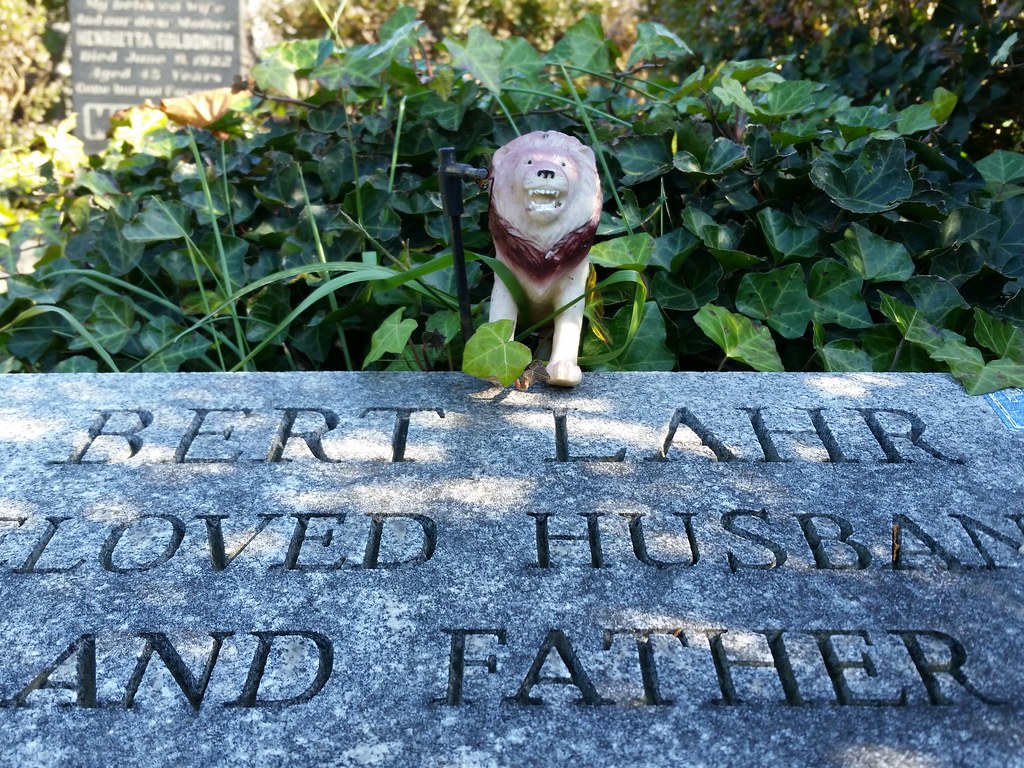
Bert Lahr is best known for playing the Cowardly Lion (video) in The Wizard of Oz, but he was also associated with another big cat: Hanna-Barbera's Snagglepuss, a seeming rip-off of Lahr whose famous catch phrase — "Heavens to Murgatroyd!" (video) — was first spoken by Lahr in the 1944 movie Meet the People.

According to historian Robert Rockaway:
Best known, perhaps, as the man who allegedly "fixed" the 1919 World Series between the Chicago White Sox and Cincinnati Reds, Rothstein is recognized as the pioneer big businessman of organized crime in the United States. A man of prodigious energy, imagination and intellect, he transformed American crime from petty larceny into big business. One social historian described him as "the J.P. Morgan of the underworld; its banker and master of strategy." . . .
During the 1920s, Rothstein put together the largest gambling and bookmaking empire in the nation, masterminded a million-dollar stolen bond business, and controlled most of New York's gangs, as well as that city's traffic in narcotics, bootlegging and gambling. . . .
With the coming of Prohibition, Rothstein's business empire developed another dimension — bootlegging. Rothstein laid the foundation for the enormous profits of Prohibition by creating an organization to buy high quality liquor by the shipload in England and distribute it to buyers in the United States. This idea caught on and soon others were engaged in the same enterprise. . . .
He next turned his talents to narcotics smuggling which, until he became involved, had been unorganized. Rothstein converted the racket into a businesslike machine by sending buyers overseas to Europe and the Far East, and by controlling the purchasing operation in the United States. . . . By 1926, Rothstein was allegedly the financial overlord of the foreign narcotics traffic in America.



